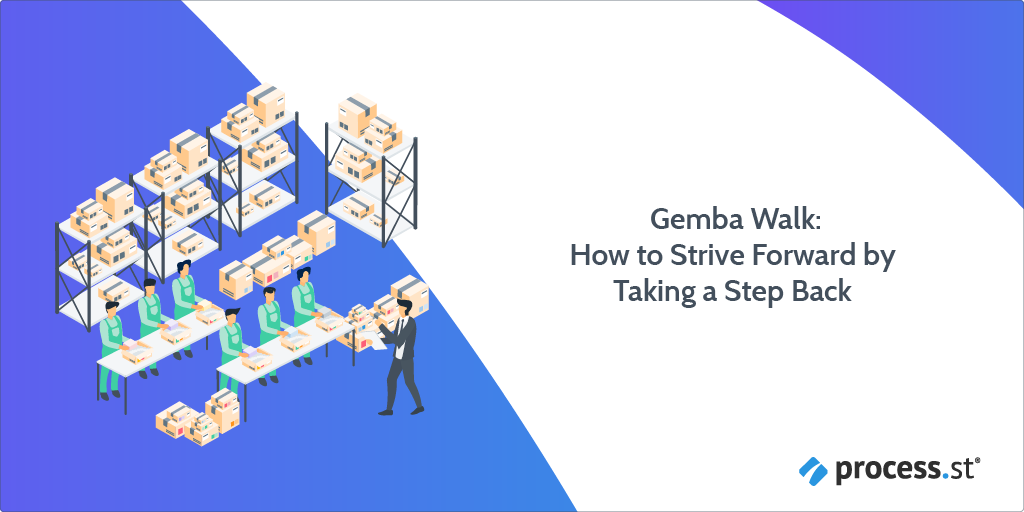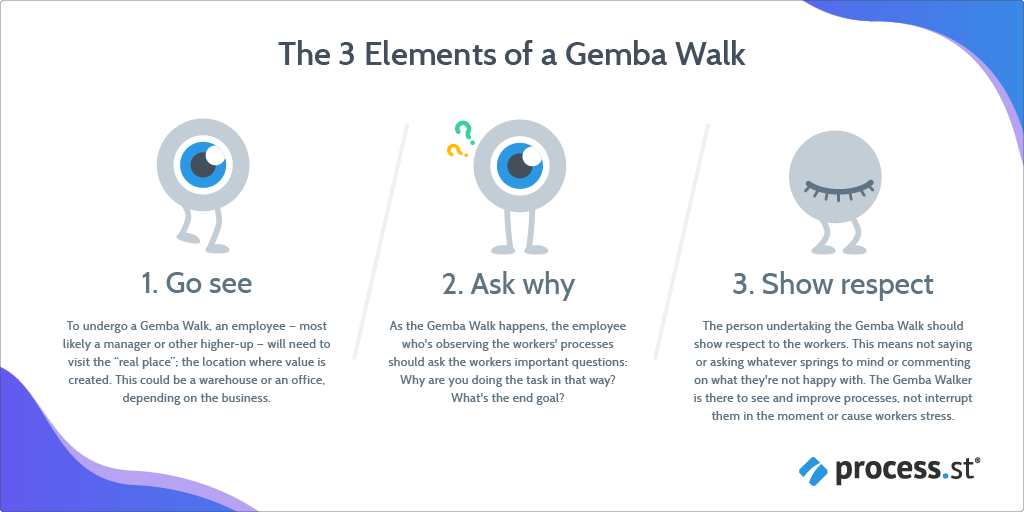
You’ve heard of the moonwalk. But have you heard of the Gemba Walk?
From a business standpoint, the Gemba Walk is infinitely more useful (though the moonwalk is pretty cool).
Specifically, the Gemba Walk allows businesses to continuously improve how they do things by remedying their processes, procedures, and workflows for recurring tasks. The continual process improvements that Gemba Walking brings helps businesses exponentially – 1 in 4 improvements save time, and 1 in 10 improvements save money.
And this is all achieved by simply stepping back, rather than blindly pushing forward.
Want to know more?
I thought so.
In this post, I’ll tell you what Gemba Walk means, the origins of it, its benefits, and how Process Street can help both remote and physical businesses do the Gemba Walk.
Just read through the following sections to get clued up:
- What is a Gemba Walk?
- The origin of Gemba Walks
- The 3 elements of a Gemba Walk
- The benefits of Gemba Walks (& lean management)
- Undergoing process improvement with Process Street!
Now, let’s sprint through the rest of the post! ♂️
What is a Gemba Walk?

The Gemba Walk is an evaluative process where a manager, executive, or other employee takes a break from their regular tasks to see how others are performing theirs.
In a warehouse, an employee physically walks around the space to analyze how people are going about their processes, looking for opportunities where processes could be improved. For instance, perhaps the routes the forklifts take when moving items could be bettered.
While on the topic of warehouses, check out this warehouse safety checklist template:
For other types of businesses – let’s say a marketing agency – it could take the form of noticing how the team is completing their marketing tasks, whether they’re following documented marketing processes properly, and whether their methods are an improvement or a regression of those established processes.
The word “Gemba” (or, less commonly, “genba”) means “the real place” in Japanese. In the context of lean management, “the real place” is where the real work gets done — a warehouse for a retailer, an office for an agency, a football stadium for football teams. So, by going to the front-lines where this crucial work happens, problems related to processes can be noticed and then tackled, thereby ensuring success.
If the term “lean management” is new to you, let me clear that up, too.
What is lean management?
Lean management (sometimes known as lean manufacturing or lean production) is a methodology for creating maximum value by optimizing resources. Essentially, this means ensuring your business is running like a tight ship, and that your processes and procedures are never wasteful.
As Rene T. Domingo explains in the Identifying and Eliminating The Seven Wastes or Muda:
“The elimination of waste is the primary goal of any lean system. In effect, lean declares war on waste – any waste. Waste or Muda is anything that does not have value or does not add value. Waste is something the customer will not pay for.” – Rene T. Domingo, Identifying and Eliminating The Seven Wastes or Muda
For reference, “waste”, in Japanese, is “Muda“.
Seeing as the Gemba Walk is all about making processes and procedures the best they can be, Gemba is an important part of lean management!
With those two definitions covered, let’s take a walk through Gemba Walk’s history.
The origin of Gemba Walks
 Although the word “Gemba” is used in a myriad of different contexts in Japan — for instance, detectives refer to the scene of a crime as the Gemba – the western world knows Gemba best in relation to process improvement.
Although the word “Gemba” is used in a myriad of different contexts in Japan — for instance, detectives refer to the scene of a crime as the Gemba – the western world knows Gemba best in relation to process improvement.
Here’s why.
While working at Toyota, Taiichi Ohno devised various methods, programs, and processes so the Japanese company could cement themselves as the best car manufacturers in the world. If Ohno’s name looks familiar to you, that’s because he’s a process improvement genius – he developed the 5 Whys process, which I wrote about at length.
One of the other concepts he created for process improvement was – you guessed it – the Gemba Walk. And considering how profitable and well-known Toyota is in the contemporary world, it’s safe to say that Ohno succeeded in his mission, and his concepts and processes work well. Especially as they’re now being used by businesses large and small across the globe.
To put it bluntly, the Gemba Walk isn’t some made-up mumbo-jumbo: It was created by one of the greatest minds in the field of process improvement.
But what, exactly, are the elements that a Gemba Walk consists of?
Let’s take a look.
The 3 elements of a Gemba Walk
 The Gemba Walk is comprised of 3 main elements:
The Gemba Walk is comprised of 3 main elements:
- Go see
- Ask why
- Show respect
Firstly, an employee (or group of employees) need to go to the Gemba – the location where important work happens. Then, the employee or group of employees walk through the Gemba, keeping their eyes peeled on their fellow employees and seeing how processes are being done. This element is known as “Go see”.
The second element – “Ask why” – is when the employee or group of employees ask the workers why they’re doing their processes in the way they are. This stage is all about gaining insight and hearing what the workers have to say, rather than talking at them.
The third element, known as “Show respect”, is more of a mantra than anything else. It’s important for the Gemba Walker or Walkers to understand that they’re not there to judge or tell people what they’re doing wrong as a boss would. Instead, they’re there to observe, to see, to notice. Once any problems have been observed, changes can be made to processes and procedures to ensure they’re no longer wasteful.
This is the Gemba Walk in a nutshell.
Depending on what industry your business is in, the place you conduct a Gemba Walk in will be different. But the elements involved won’t change.
The benefits of Gemba Walks (& lean management)
 At its core, the Gemba Walk is all about observation and using that insight to make profound, positive change.
At its core, the Gemba Walk is all about observation and using that insight to make profound, positive change.
If you haven’t researched Gemba Walking or not undertaken it before, “profound, positive change” sure sounds swell, but those positives might seem a little abstract.
So for full transparency, let’s take a look at the inherent benefits the Gemba Walk brings.
Specifically, it:
-
- Helps businesses optimize their processes & procedures.
There are multiple benefits that Gemba Walking brings, but it’s process optimization that’s the star of the show. By optimizing processes for the better, businesses can increase team productivity and surpass the KPIs they’re setting, complete processes quicker (and in smarter ways), and even gain more revenue as a result. Moonwalking? Pfft. It’s all about the Gemba Walk.
-
- Ensures processes & procedures aren’t wasteful.
Process improvement and reducing wasteful actions or steps in a process go hand-in-hand. Like Yin and Yang, they’re both interconnected. And it’s through ensuring there’s no Muda (waste) in a process that its next iteration is an improvement on the one that came before.
-
- Minimizes resistance to change. ⬇️
As humans, we need to adapt to the changes that life throws at us, and the same sentiment applies in the business world. After all, flexibility is what stops businesses from stagnating. And by undertaking regular Gemba Walks, processes are always being optimized, tweaked, and altered for the better. This helps employees keep an agile mindset, and not be resistant to change.
-
- Provides clarity by taking a step back.
In the world of business, it can often feel like a relentless race to keep pushing forward, to always keep striving. But this isn’t always conducive to business – at least, not if core processes and procedures are holding a business back. But with Gemba Walks, it allows employees – and the business as a whole – to take a step back. By doing this, problems and holes can be noticed and provides the Gemba Walkers with clarity. Then, with that clarity, the necessary changes to processes can be made.
-
- Plus, it’s easy to do!
A Ph.D. isn’t necessary for an effective Gemba Walk to take place. Hell, it doesn’t even need much further reading! All that’s required is a moderate understanding of Gemba and Gemba Walking, a pair of knowledge eyes or two, and a checklist to guide the Gemba Walker through the process. To boot, you don’t need to hire an external auditor to come in and look at processes: In fact, the Gemba Walker absolutely needs to be somebody who’s already an employee at the company in question.
There you have it – a short but insightful list of Gemba Walk benefits.
The additional good news is that this list by no means an exhaustive one; the 5 aforementioned benefits barely scratch the surface! The Gemba Walk is also just a small part of lean management – imagine the other rewards that can be reaped by fully committing to lean management…
Sorry. I was getting ahead of myself there.
Back to the Gemba Walk.
If you’re raring to get started with the Gemba Walk, you’ll want to use a checklist to help guide you through the process and ensure it’s done correctly.
It just so happens that with Process Street – which is state-of-the-art BPM software – you can create nifty checklists for anything and everything.
Undergoing process improvement with Process Street!
Process Street is superpowered checklists.
If you document workflows, business processes, and integral procedures as templates, you and your team can then launch checklists from those templates. Checklists help teams complete recurring tasks properly and keep human error at bay.
For Gemba Walk specifically, you can create processes that you or other Gemba Walkers follow.
Additionally, you can document all your employees’ processes as checklist templates, too. This means when a Gemba Walk has been undertaken and you implement changes to processes, the checklist templates can also be updated.
Whenever employees launch checklists from the updated checklist templates, they’ll always be following the best iteration of that process. It also ensures employees don’t get confused and revert to inefficient processes!
Sound good?
Of course it does.
Check out the video below for a visual introduction to Process Street’s nifty checklist app.
If you’re wondering what makes our checklists superpowered exactly, it’s our workflow automation features. By adding these features to checklist template tasks, you and your team can collaborate like pros.
The features include (but aren’t limited to):
- Stop tasks ✋
- Dynamic due dates ⏱
- Conditional logic
- Task permissions
- Task assignments
- Role assignments
- Embed widget
- Webhooks
- Approvals ✅
For a deep dive into some of these features, watch the webinar recording below.
Ready to get started?
Just sign up for free and start documenting processes yourself. If you need a few exemplary templates to look at, don’t forget to take a look at our massive (and free!) template library. The library is brimming with useful templates like the FMEA, VRIO, SWOT analysis, 5 Whys, and SMART goal setting templates.
More resources for making process improvements
You’ve now got your brand new, shiny Process Street account to help you with process improvement. But to help you accel even further, here’s a list of related reading material.
These posts are all to do with process improvements, so put the kettle on, take a seat, and get learning.
- Implementing Processes: How to Boost Success Rate by 70%
- Process Improvement: Stop Bad Processes Killing Your Business
- What Continuous Improvement Is (and How to Use It)
- Business Process Optimization: What, How, Why? (Free Templates)
- Kaizen: How to Deploy Continuous Improvement to Rocket Your Success
- The 7 Core Six Sigma Principles to Build Your Business Around
- PDCA: How to Eliminate Error in Your Processes and Products
- 9 Lean Manufacturing Principles to Kill the Jargon and Get Quality Results
- What is Muda? The 7 Wastes Every Lean Business Needs to Combat
- DMAIC: The Complete Guide to Lean Six Sigma in 5 Key Steps
Happy reading – and happy Gemba Walking!
Have you undergone a Gemba Walk before? Are there any tips and tricks you’d like to share with the Process Street community? If so, write down your comments below!







 Workflows
Workflows Projects
Projects Data Sets
Data Sets Forms
Forms Pages
Pages Automations
Automations Analytics
Analytics Apps
Apps Integrations
Integrations
 Property management
Property management
 Human resources
Human resources
 Customer management
Customer management
 Information technology
Information technology



Thom James Carter
Thom is one of Process Street’s content writers. He’s also contributed tech-related writing to The New Statesman, Insider, Atlassian, G2, The Content Marketing Institute, and more. Follow him on Twitter @thomjamescarter.